|
|
Review of GSM-handset Sony Ericsson Z710i
Live photos of Sony Ericsson
Z710i>>>
With the introduction of its very own Walkman range, Sony Ericsson has made it a rule to release twin models and what initially seemed to be just minor differences in design and sales package, is growing into something bigger now. When facing off the Z710i and the W710i, we see that the Z-labeled handset for “masses” carries no sporty features like pedometer and calories counter and consequentially, is offered at a lower price, which is reduced even more owing to absence of rubberized casing, unclaimed by the mass market. The good things about the new model also include changed backlighting color from orange found on the W710i to the Z710i’s blue. The fact the design has remained untouched acts in the company’s favor, as the succession doesn’t get dissolved throughout the line-up (which retains such phones as Z520i, Z530i and W300i).



The Z710i comes in two colors - Twilight Black and Metallic Sand. Both trims look quite good and appear to be aimed primarily at youth; the white finishing makes the device seem visually smaller. The Z710i measures 88õ48õ24.5 mm, and weights 101 grams.


The handset’s image is forged mainly by the external display – the first users called it an “aquarium”. Measuring 1.5 inches in diagonal (26x26 mm), it retains some major advantages of monochrome screens over color ones –they perform much better in sunlight in the first place. That is how come a monochrome display with 128x128 pixels resolution, blue backlighting (inversion type, 4 gradations) is included in this handset. Obviously, you won’t be able to use PhotoCall, so, on incoming call you will get only name and number. When closed, the display may show status information and notes taken from the calendar for current day. All in all, the screen is really decent – one even might call it a TV as a joke. When media player or radio are running, all data they have to offer (track name etc.) is displayed on the screen and provided font size only adds to overall positive impression.
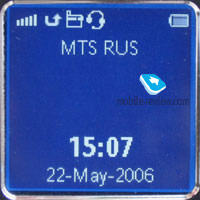 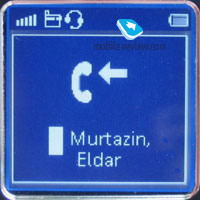

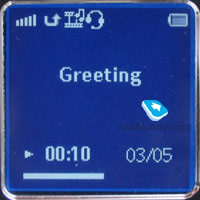 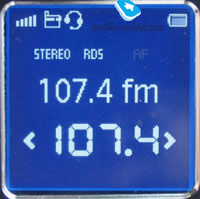
On the front you will find a 2 Mpix camera module, encircled with a metallic ring. The camera itself is powered by CMOS technology without auto-focus capability being embedded in, and thus resides in the same class as Sony Ericsson K610i.

Side-mounted camera shortcut button does not work when the phone is closed. Volume rocker key is located nearby. “M2” label is located even lower, yet it isn’t the place where the memory card usually resides in – in fact it finds its place under the battery cover, thus no hot swap in full sense of this word is available on the Z710ii, to cut long story shot, it isn’t a problem to change cards on a working phone, though the back cover is to be removed in any case.

The bottom rim homes a standard Fast Port connector, while the upper end has a loop antenna on it. The right side features Infrared port, and a key lock switch, which comes in handy when training.

The handset is easily opened single handedly. The internal display is 1.9 inches big, retaining a resolution of 176õ220 pixels (31õ38 mm) and showing up to 262 K colors (TFT). The display is on the same level with that of Sony Ericsson K750i, but is evidently weaker that current top models of the company, namely Sony Ericsson K790i. The sun seems to be not a big deal for this screen as well.
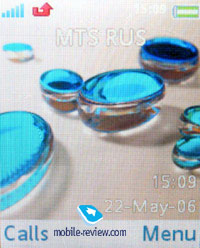
The keypad is made of plastic with medium-sized well-demarcated numeric keys. On the whole the pad leaves good impression and proposes the following standard features: all buttons are lit in dim blue, which is fairly visible in darkness; the four-way navigation button is made of metal and incorporates “OK” key. All in all there is nothing to gripe at with this keypad.



The back cover has a latch, which helps a lot in avoiding gaps. Removing it reveals a 900 mAh Li-Pol battery BST-37. As the manufacturer claims, it lasts for 350 hours in standby mode and close to 10 in talk mode. In conditions of Moscow networks the device remained on for nearly two days with average load (one hour of calls, approximately 30 minutes of games and about 20 minutes of web-surfing). The heavier load the less the charge will last, so that it may turn out you will have to re-charge it daily. And on the contrary – if you reduce talk time to the very minimum, the battery will provide up to 3 days of stable work. In European networks life time will be significantly longer, owing to better coverage.



The handset ships with only a standard stereo-headset, since the Z710i has no aim at pretending to be a music phone, while the W710i’s package features a special headset and an armband. Nevertheless you are free to plug in such music-centric earphones, yet it will cost you extra 50 USD (price for HPM-70)
Menu
On the announcement of Sony Ericsson K790i/K800i everyone was prepared to see more clones of that platform coming in different form-factors. So is Sony Ericsson Z710i (it can be referred to Sony Ericsson K610i as well), which copies the K790i in many ways. At first we’d like to have a better glance at all the major alterations and additions to the interface and then mention the capability, retained by a number of handsets, already reviewed on our portal.
The model lacks 3D accelerator and takes advantage of a standard API one, mark this point well. The sequencer found on this model has 72 tones, but makes sense only when playing midi-tracks, in all other cases it is better to apply mp3 or even eAAC+.
Bluetooth version for this model is 2.0, it supports EDR you can save improved energy saving mode in the menu. A2DP module is supported, this allows using wireless stereo headphones. The module itself (Bluetooth) was reworked, now it has wider capability with 3rd party devices. Considering the fact that common realization of this technology by Sony Ericsson is rather good (above average), no major problems should be encountered. The handset supports EDGE class 10.
Multitasking of this device matches that of a smartphone, and is far superior to a standard handset’s one. We tested this capability with the media player running, as well as three Java-applications (two games and World Time functions) and on top of that the pedometer was counting steps at the same time. At that there were no problems with managing these applications in Activity Menu mode – everything was like clock-work.
Standard applications and UI
The interface of the models seems familiar, as it doesn’t differ from all other Sony Ericsson devices: the main menu has the appearance of a grid, consisting of 12 icons. Shortcut number navigation feature is onboard – these shortcuts can be created for the majority of pre-installed by the manufacturer items on the menu, though this option is disabled for personal files and applications.

Text input remains on the same level of comfort, so, pressing the "#" key brings out a list of the available languages and you can easily switch between them while typing.
Apart from traditional vertical sub-menus, the manufacturer has provided subject-based horizontal tabs. It means that while viewing a list of the dialed numbers, one can see not only the dialed numbers but in the same time (horizontal joystick deflection) switch between missed and received call tabs. In the phone menu this kind of navigation is provided anywhere it's possible and it makes using the phone much easier. The menu ergonomics is quite high in this phone model. I also note that such horizontal panels appear in Phonebook, Settings and another menu items as well.
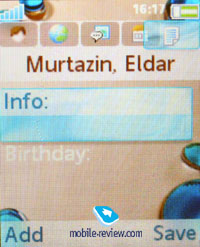
Enhancement of Activity Menu functionality is the result of the fourth tab addition. The first three ones contain various events, like missed calls, memos, messages – actually all this regards the first tab. One can disable Activity Menu for these events as well – in this case pop up windows, reminding of a certain event type will start appearing on the screen. The third tab features the shortcuts, which you should set up yourself. And the added fourth one contains links to the most frequently used applications and resources – and the top of this list is claimed by Google search. To tell the truth, the way Google trade mark affects consumers can be compared to voodoo conjuration. That’s why this search engine is used by several other manufacturers as well.
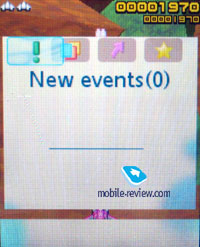
The second tab is the most interesting one, since it appears to be some kind of a task manager, featuring the list of all running applications. The previous handsets by Sony Ericsson supported only a simple way of handling multiply tasks – you could play a Java-game, listen to the radio or player and type a message at once. Though these devices made one more step forward – user is able to run two Java-applications at a time and switch between them. This may come in handy, in case you use an ICQ-like mobile client, which should be constantly online, and at the same time want to play a Java-game. Up to now other manufacturers haven’t any devices boasting something similar in their portfolios – however Nokia is scheduling introduction of this function in its handsets for the end of 2006 – beginning of 2007.
The updated USB-connection function can be rated as innovative as well – from this point on you’ll have to choose beforehand whether files on memory card will be accessed or not (data transfer mode). In the former case, the device shuts down, so you’re able to browse memory card and in the latter one you are offered various USB settings for accessing the network – basically the handset transforms into a modem. As far as I remember similar implementation of this function was featured only in Motorola ROKR E2, where you could use USB Ethernet (though the main point here and there is the same).
Phonebook. Up to 1000 contacts with fully filled in fields can be stored in the phonebook, but the total amount of phone numbers is limited to 2500. This means that despite being able to assign up to 5 phone numbers to one contact, you cannot go over 2500 entries. Anyway, this is quite enough even for the most active users, as only few have more than 500 entries in their phonebooks.
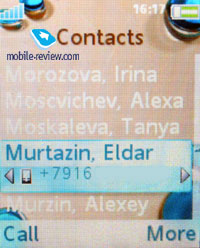 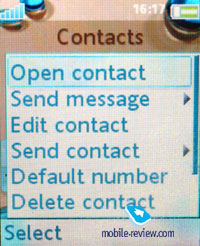
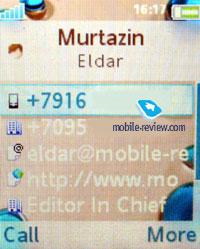 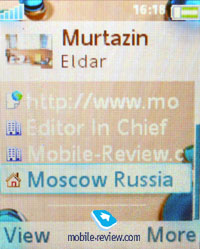
 
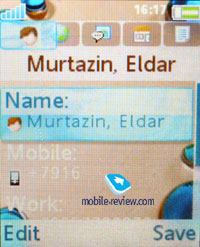 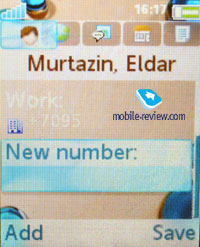
 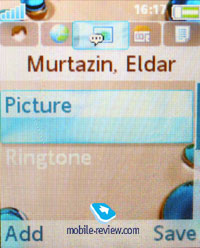
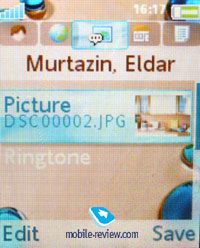 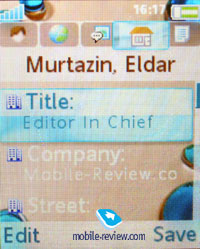

Like I mentioned above, several phone numbers can be stored for one contact, as well as address, email, IM number and other information. In settings you can select the required fields that will be displayed, meanwhile the useless ones will be hidden. Contacts can be sorted by fields, including first name and last name, but only one input field is available. Unlike previous models, this time we have a dynamic process here, i.e. handset automatically sorts the list after changes.
It is possible to assign custom ringtone and photo to each contact. On an incoming call the bound image and ringtone will be used. Birthday field can be synchronized with Organizer.
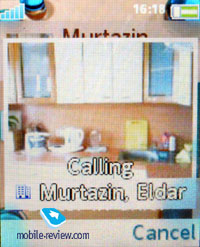 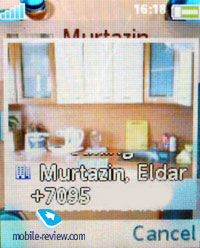
When submitting information, you can scroll between tabs, in the first one you enter phone numbers, their sorting by types. On the whole the organization of this process feels similar to that of Outlook, and it means comfort in the first place. Voice tags can be added for required phone numbers, names, there can be up to 40 of them. Voice dialing feature remained the same, although it starts looking archaic with all these voice independent recognition software being implemented by competitors.
When scrolling through the contacts, you can try deflecting the joystick to the left or right to see more information on highlighted contact. Default number is, of course, must be assigned by you. From now on Open Contact option is available in the context menu, it allows viewing the whole contact without going into editing mode, as it was before.
The company still follows its traditional beliefs that SIM-card is used for storing data only in case of emergency, that’s why the only way to see its contents is to call up special option in the menu. SIM contacts are not displayed in phonebook.
You can create back-up copy of all entries from phonebook that will be stored on the memory card, so you will have the ability to restore them afterwards.
Contact Groups are required only for mass SMS sending, since it is impossible to bind custom ringtone or photo for Group.
Messaging. The phone offers pretty much standard ways of handling messages with a number of templates being available and there is still room for custom ones. Handset’s memory together with SIM-card is used for storing messages. Chat function is supported. On the whole everything is just like in any other phone by Sony Ericsson. Only emoticons icons were enhanced, so that now they look more appealing.
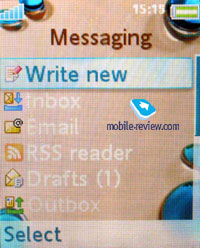 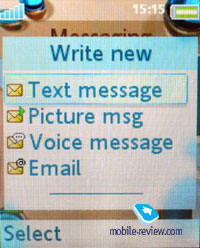
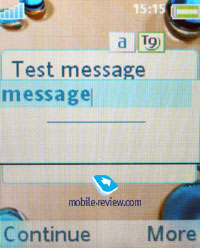 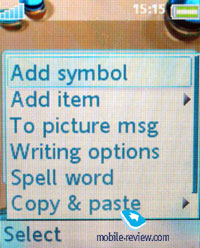
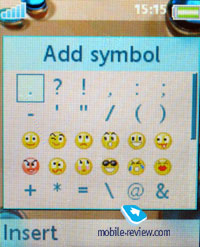 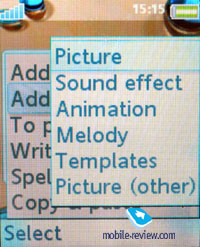
 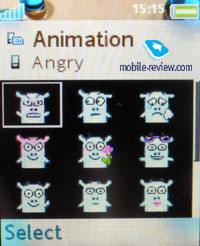
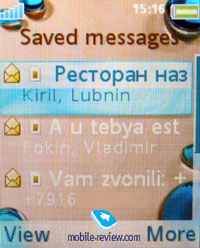 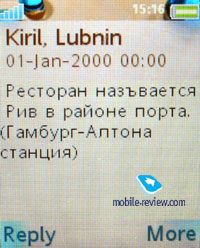
The MMS implementation is great as always, you can literally create video clips, there are lots of settings and this is one of those things that gives SE’s product advantage over competitors.
E-Mail client can send and receive emails, all sort of encodings are supported. The emails can be stored to memory card.
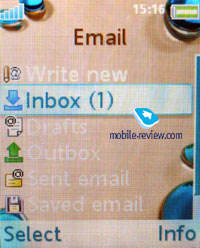 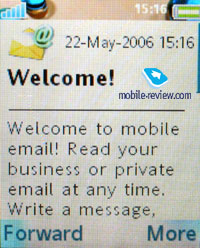
Using the email settings you can setup separate password for SMTP-accounts, this is very convenient. Settings are quite flexible, since support for almost all encodings, not only Unicode, was added. Attachments supported by the phone are presented as icons in an email’s body. The phone cannot manage office files or PDF, but they can be stored in any folder. The limit for outgoing/incoming email size is set by operator. Emails with 6-7mb attachments can be sent without any problems. The phone supports Push Mail standard. Naturally send & receive process is carried out in background mode.
RSS Feed. The settings are extremely simple to adjust - you just specify the title for feed and its address. The phone will connect and download it. You can update either only one item, or the whole feed at once. Capabilities provided by the built-in browser are used for displaying the feeds.
Call lists. Up to 30 records can be stored in the general list, all with assigned date and time. Icon that stands for call type (missed/received/dialed) is shown next to every entry. Apart from this, an additional icon identifies whether this phone number is stored in the phonebook or SIM-card. The list of missed calls can be checked out separately, it stores up to 10 entries. In this menu you can also see the cost and duration of calls, outgoing calls and last call. Owing to the tabbed menus, navigation gets a lot easier.
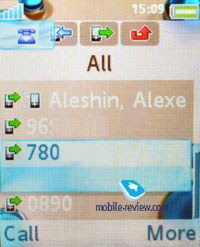 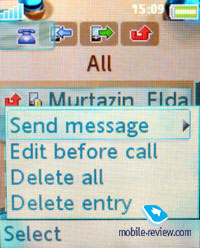
Entertainment. Photos, music files can be accessed from this menu. MusicDJ function is rather interesting, even though it is a high profile solution and there is not much of a chance that this feature will be highly demanded by users. In the editor you can create and edit ring tones, up to four tracks.
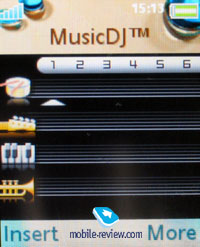
Advanced version of MusicDJ is called VideoDJ, it allows editing not only music files, but also adding images and signs. The resulting clips are encoded in 3GP format, which can be sent via MMS or Email, or just transferred to another phone.

The creative ones can use graphical editor PhotoDJ, you can draw simple images. Occasionally, time flies when you’re having fun with PhotoDJ, but most of the time this feature is just useless.
Remote control – provides the ability to manage other devices via Bluetooth connection. It is standard for all phones by Sony Ericsson
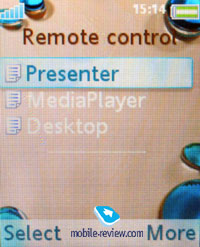
Sound can be recorded with the Sound Recorder; it allows making voice tags that can be later used as ring tones. Phone calls can be recorded too, this is done from context menu and more importantly, there is no time limit set.
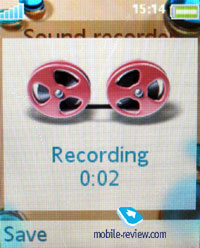 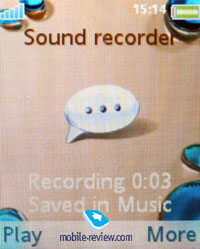
Games – the phone has two games onboard: Alpha Wing2 (space arcade), Treasure Tower (a good adventure/arcade).
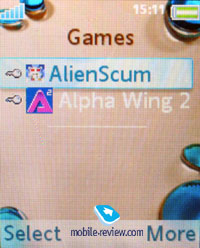 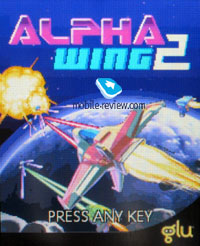
 
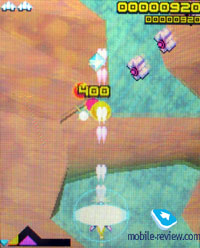
Radio. The handset can memorize up to 20 radio stations, auto-search and RDS functions are implemented. The radio quality and looks are the same as in case with K750i, which means they are on a good level. FM-radio would seem like an ordinary application, if only it did not have Identify Music option in the menu. While you are listening to any radiostation and a thought “I want to know the title of this song” pops up in your head, you can find the answer with the help of this feature. After activation it will store about 3-4 seconds of the song and connect to special server that will analyze the song. The result will be presented as tag scrolled in the upper part of the screen (horizontal and vertical orientations supported). At first this service will be free for SE users, it will be launched approximately this summer.
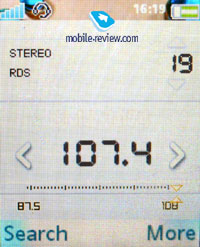 
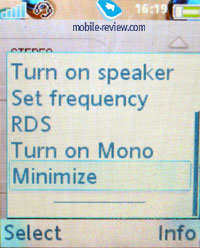
Music Mate. The application that will come in handy should you want to learn more about playing on some musical instruments. Nothing comes into limelight special here.
Organizer. Organizer item keeps a lot of functions underneath. Let’s review Calendar in the first place. There are three layout types for viewing the events: weekly, monthly and today. In the last option you will see list of all events and memos, in two others - highlighted time or day. You can switch to required day and year, or month. Everything is pretty standard, as well as schedule input. You get the chance to name the event, define the place where it will be held, its length and setup the reminder (in advance or right at the start of the event). For the first time events acquired reoccurrence option. Types of reoccurrence: daily, monthly. Reminders trigger off even if the phone is turned off, unless you disable this function.
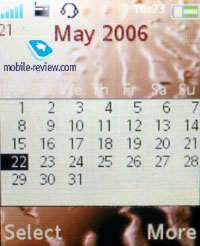 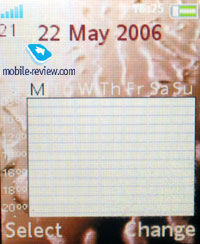
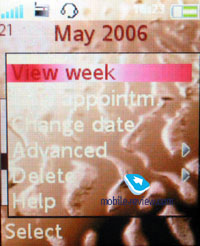 

To do list in this phone is quite ascetic. There are only two types of events: phone call and reminder. On the other hand, this is really enough, simplicity has its advantages.
The handset carries a has full-fledged search engine for calendar: you specify the search line (word or a part of it) and after a while you will see all events that match submitted criteria. The function works rather fast even if the organizer has more than 100 entries, fast switch to the event from the search window is supported.
The phone features unsophisticated way of transferring calendar to various devices (traditionally via IrDA and Bluetooth): You choose the required interval (day, week or month) and send all entries. I’d like to point out that the device should support PIM function in order to open and display this data properly. It is possible to send the schedule to TV-set through IrDA connection, the TV-set accepts it but is unable to display the received information. Data can be received in the same way, with the help of desktop or office PC without any additional software being required.
Notes. The phone supports notes of limited length. The name of the note will be first word entered. This is not always convenient since you will have to use first word that would automatically tell you what the note is all about.
Alarm Clock. We’ve got changes in this one, now you have five alarm clocks, with each of them being available for setting up. They can work in definite week days. Besides the ringtone for alarm clock you can selet small note and picture, they will be displayed when alarm clock goes on. Any music file or radio can be seleted as the alarm itself.
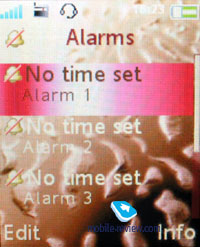 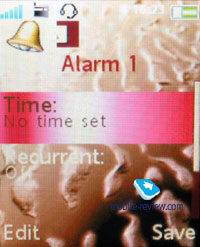
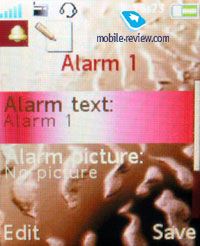
Stopwatch/Countdown. Here everything is quite standard, although the same can be said about the stopwatch, that has intermediate results function. The phone has special application for storing secret codes, which was a great hit in previous models, well, standard calculator is present too.
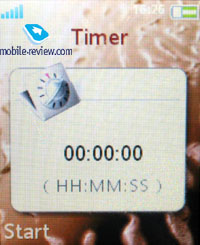 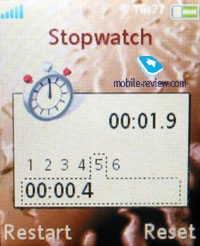
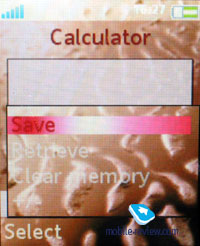 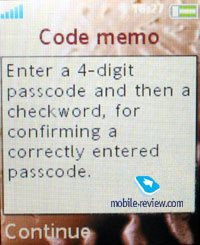
World Time function is onboard as well.

Connectivity. All communicative settings for the phone can be setup from here, starting from WAP and GPRS (the EDGE settings are the same) and ending up with Bluetooth and Synchronization. I will not describe the standard options, they are of no interest, and everything works fine. I’d rather like to highlight stable Bluetooth work, no problems were encountered, synchronization with other devices runs smoothly, all profiles (including A2DP, which is stereo sound via Bluetooth) are supported. Bluetooth version is 2.0 with EDR support.
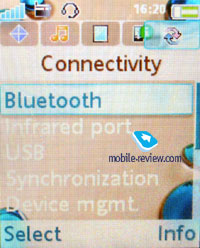
Local and Remote synchronization can be setup from the same menu. The phone supports HID profile which allows using it as Remote control for PC and other devices.
The following Bluetooth profiles are supported:
- Dial-up networking profile
- Generic Access profile
- Generic Object Exchange Profile
- Object Push Profile
- Serial Port Profile
- Handsfree Profile
- Headset Profile
- Synchronization Profile
- Basic Imaging Profile
- File Transfer Profile
- HID Profile
- SyncML OBEX binding
- JSR-82 Java API
- A2DP
WAP. The browser ver 2.0 owns a separate menu item; it supports secured connections which is quite important in case you are using electronic transactions. New wallpapers, themes and ring tones can be downloaded right away, it’s all available at the original web-site.
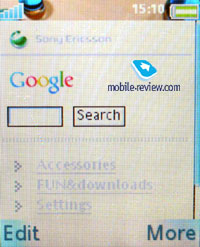 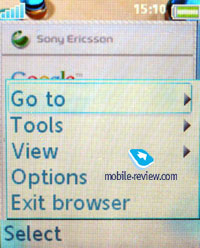
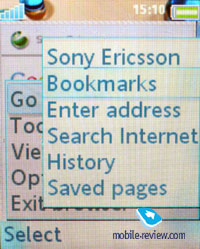 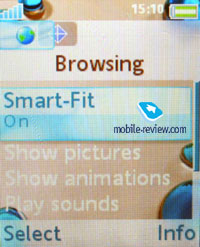

Standard browser for Sony Ericsson phones is NetFront, it supports one-line web-page display and HTML. One of the convenient things is ability to create folders with files and bookmarks. The browser is considered to be one of the best on the market, but limited phone resources do not make using it a breeze. On the whole those who surf Internet frequently should consider buying PDA or laptop, since full Internet access is not in such high demand for this device class. At the same time RSS Feeds support is great, it allows using the phone for reading news, announcements and articles.
HTML pages that content advanced formatting or exceed 500kb in their size will not be displayed. On the whole standard browser is optimal, but usage of Opera Mini is preferable, since it has more features to offer
Settings. This menu stores all settings related to handset’s operation and partly to its outlook. In standby mode clock can be displayed at the bottom (on/off), you an also choose the font size, in case you select big letters it will be easy to see what time it is, but the font itself becomes transparent. There isn’t anything to add, all the rest of the features are standard.
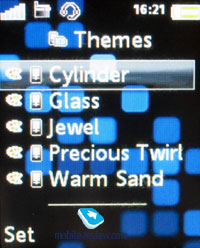 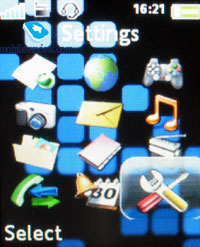
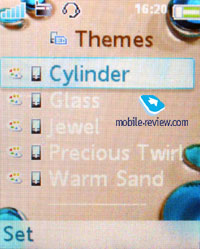 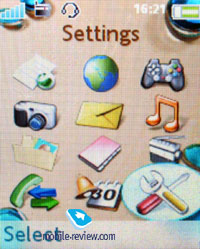
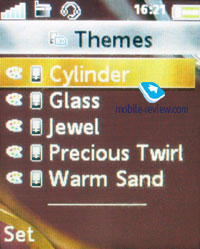 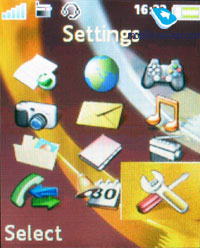
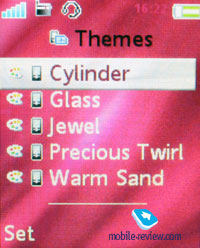 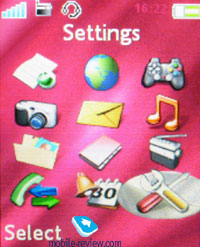
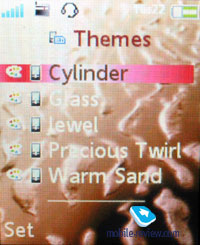 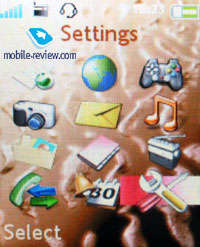
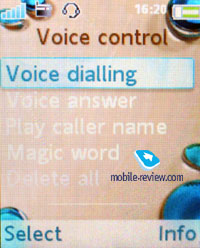 
 
File manager, memory size. The user has 10 MB of available memory, add a M2 memory card to that too – any type of data (photos, videos, applications) can be stored there. The remaining memory is occupied by preinstalled applications, which cannot be deleted. A part of the memory is dedicated to phonebook, call lists, etc.
The phone has a basic file manager, with its help files can be sorted by various folders, custom directories can be created in phone’s memory, files can be moved there as well. With or without cable the phone can become a perfect portable storage, there are no problems with recording your own files, even if they cannot be opened by the phone.
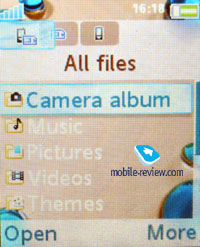
Traditional file sorting includes the following options: date, type and size. The Image Gallery has new setting called Timeline, after you activate it you will see a month-bar, while in lists you will see photos that were made during certain months. You can make the list more detailed by pressing the same key twice, in that case you will see days instead of months, meaning that photos will be sorted in the following structure: list of images made on October 3rd, for example. This is a good way to wander around tons of images, should you have such on your handset
Player. The phone has a built-in mp3 (AAC, eAAC+, WMA formats are also supported), 3GP and mpeg4 player, which proves to be enough for playing back mp3 tracks. Apart from that you can tune the equalizer (there are some pre-installed settingssettings: Bass, Voice, Tremble, etc), as well as the ability to create your custom ones. The equalizer settings noticeably affect sound delivered by the handset.
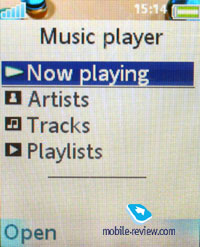 
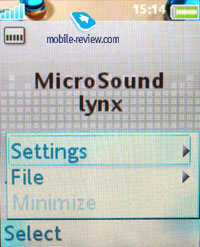 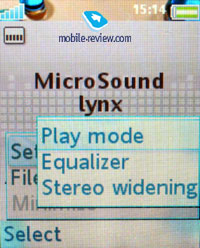
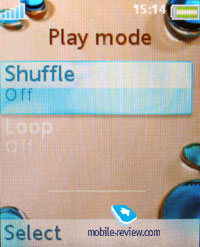 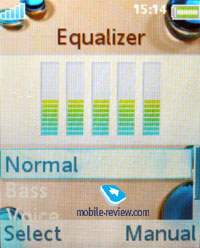
The player is similar to the one Sony Ericsson W800i, it replicates it in most ways. It is possible to minimize the player, as the phone supports fully supports multitasking. There are no concerns about this media player at all, even though it’s weaker than the one used in Sony Ericsson W950i.
Camera. The device is equipped with a 2 MP camera with a CMOS matrix without auto-focus. The device supports three possible resolutions - 1632x1224, 640x480, 160x120 pixels. Two types of data compression (Normal and Fine) are at your disposal. The majority of the sample photos are in the Fine quality. The photos differ in size almost two times depending on the resolution. Thus a photo in the Normal mode takes up about 300 KB while the Fine quality results in 500-600 KB. Saving the photo takes the same time not depending on chosen type and makes about 1-2 seconds, and that is quite speedy for such file size. If to take several photos one after another (not in the Burst mode but just successively) then you'll notice slight slowdowns (up to 3-4 seconds). According to subjective feelings the device buffer includes 2 Mb of memory
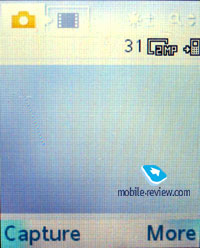 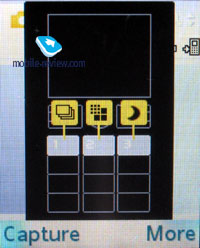
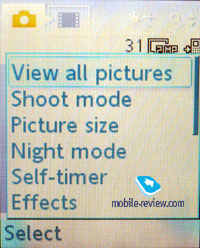 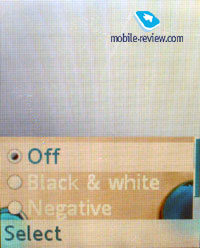
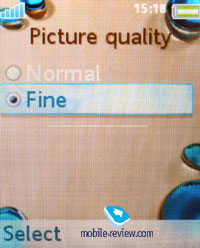 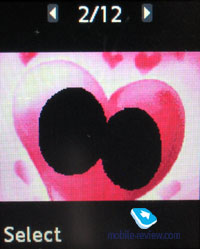
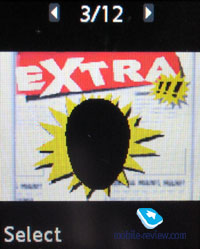 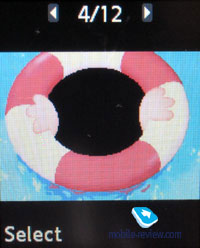
The camera settings look in the following way:
- Shutter sound. You can choose on of the three shutter sounds but not turn the sound off.
- White balance. A possibility to choose between an auto-mode, Incandescent, Fluorescent, Daylight.
- Effects. Several effects may be applied to the photos, these are Negative, Solarize, Sepia, Black & White.
- Timer is activated for a certain time period for self shooting.
- Night mode is for shooting in the dark. Noises raise on a photo, exposure time gets increased (you shouldn't move the device in order not to get a blurry photo).
- Shooting mode. Normal mode, that takes ordinary photos. Multishot-mode (Burst 4) allows taking four photos in a series. Landscape is a very interesting mode that allows taking rather fetching photos; the market hasn’t seen anything similar to date yet. The last mode is taking photos with frames, photo resolution is decreased automatically.
The screen serves as a viewfinder while in the shooting mode. The picture moves very smoothly, details don’t get dropped out. Numeric keys help in switching between various functions and shooting parameters quickly that significantly fastens work.
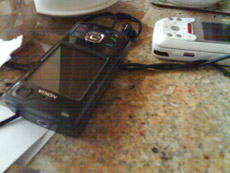 |
 |
(+)
maximize, 1600x1200, JPEG |
(+)
maximize, 1600x1200, JPEG |
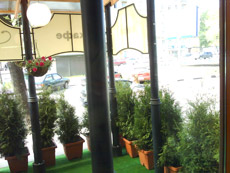 |
 |
(+)
maximize, 1600x1200, JPEG |
(+)
maximize, 1600x1200, JPEG |
 |
 |
(+)
maximize, 1600x1200, JPEG |
(+)
maximize, 1600x1200, JPEG |
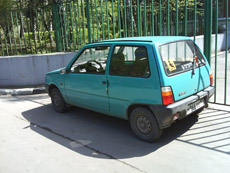 |
 |
(+)
maximize, 1600x1200, JPEG |
(+)
maximize, 1600x1200, JPEG |
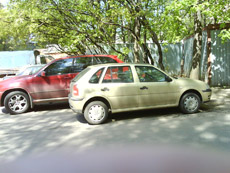 |
 |
(+)
maximize, 1600x1200, JPEG |
(+)
maximize, 1600x1200, JPEG |
Video may be recorded in two resolutions (176x144, 128x96), file format is 3GP. Clip duration may be limited (up to 10 seconds) or unlimited. The quality of the clips is average and obviously inferior to many top models.
Video sample (3GP, 176 Kb)>>>
Impressions
Despite the polyphony being 72-tone, the handset does not provide a breakthrough in sounding of mp3 tunes as compared to other Sony Ericsson branded phones. The loudspeaker is average volume-wise and has a great part of basses in its sounding, so the call is easily heard even on the street. The silent alarm is of moderate power or even slightly higher than this, but even this admission isn’t an excuse for cases when it is too weak to be felt. The receiving part is on the same level as that of other products by the company – in other words, it’s very fine.
If we are to name the model’s attractions, we definitely cannot overlook the fact that functionality-wise it’s a replica of the senior model saving for sport-centric features on the W710i and its better package. On the whole the Z710i deserves to be taken account of, and more importantly, it’s one of the most affordable devices in Sony Ericsson’s latest line-up. As for the camera module, the manufacturer has deliberately made it inferior and mostly optional here in order to avoid competition with the models topping its range.
As a matter of fact, the “280-350 USD” price-bracket offers loads of solutions, so that Sony Ericsson Z710i’s position seems strong only in the youth-aimed segment. Secondary focus is on the «still-young-30ies”, as a result the handset targets at Sony Ericsson’s usual group of consumers, where it maintains significant shares. In a nutshell the Z710i is not meant for taking over new niches – it’s just not the purpose of its release – who the handset really aims at, are people seeking for a feature-packed folder. We could list many possible rivals of the Z710i, but its only real challenge will be coming from Nokia 6131 alone. Nevertheless face-to-face comparison of these solutions is quite troublesome, as they differ in design and aesthetics, and thus have different target audiences – those, who buy Nokia 6131 have only negative emotions left by the Z710i’s looks, and vice verso. In my opinion, it’s a matter of personal taste whether to love it or hate it.


The Z710i will be distributed at the price of 300-320 USD on release, and then eventually get to the level of 270-300 USD. No doubt, this solutions has the goal to appeal to a wider audience than the senior model, Sony Ericsson W710i did, but it won’t be loved as much as Nokia 6131 (its design hardly meets the mass market’s requirements). Young people will obviously find the Z710i fetching, and furthermore, the solution’s overall functionality raises the bar for the class it comes from. For the time being it’s one of the best proposals among youth-aimed clamshells.
Eldar Murtazin (eldar@mobile-review.com)
Translated by Oleg Kononosov (oleg.kononosov@mobile-review.com)
Published — 26 September 2006
Have something to add?! Write us... eldar@mobile-review.com
|
News:
[ 31-07 16:21 ]Sir Jony Ive: Apple Isn't In It For The Money
[ 31-07 13:34 ]Video: Nokia Designer Interviews
[ 31-07 13:10 ]RIM To Layoff 3,000 More Employees
[ 30-07 20:59 ]Video: iPhone 5 Housing Shown Off
[ 30-07 19:12 ]Android Fortunes Decline In U.S.
[ 25-07 16:18 ]Why Apple Is Suing Samsung?
[ 25-07 15:53 ]A Few Choice Quotes About Apple ... By Samsung
[ 23-07 20:25 ]Russian iOS Hacker Calls It A Day
[ 23-07 17:40 ]Video: It's Still Not Out, But Galaxy Note 10.1 Gets An Ad
[ 19-07 19:10 ]Another Loss For Nokia: $1 Billion Down In Q2
[ 19-07 17:22 ]British Judge Orders Apple To Run Ads Saying Samsung Did Not Copy Them
[ 19-07 16:57 ]iPhone 5 To Feature Nano-SIM Cards
[ 18-07 14:20 ]What The iPad Could Have Looked Like ...
[ 18-07 13:25 ]App Store Hack Is Still Going Strong Despite Apple's Best Efforts
[ 13-07 12:34 ]Infographic: The (Hypothetical) Sale Of RIM
[ 13-07 11:10 ]Video: iPhone Hacker Makes In-App Purchases Free
[ 12-07 19:50 ]iPhone 5 Images Leak Again
[ 12-07 17:51 ]Android Takes 50%+ Of U.S. And Europe
[ 11-07 16:02 ]Apple Involved In 60% Of Patent Suits
[ 11-07 13:14 ]Video: Kindle Fire Gets A Jelly Bean
Subscribe
|

























































































































